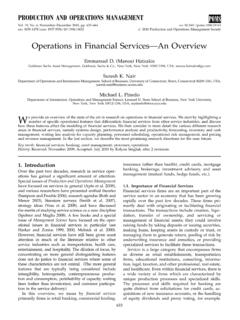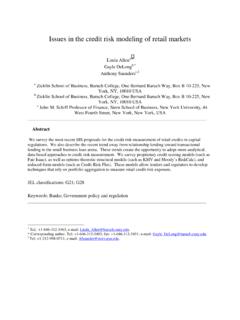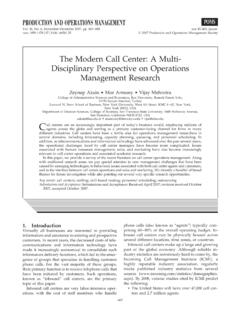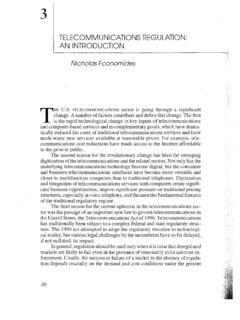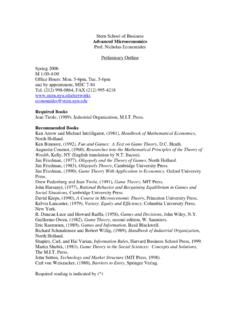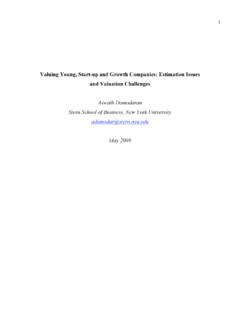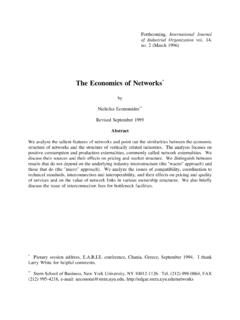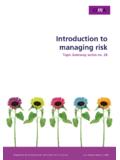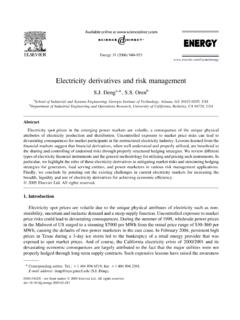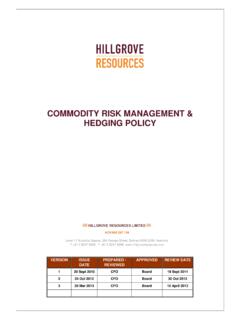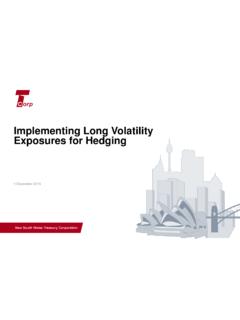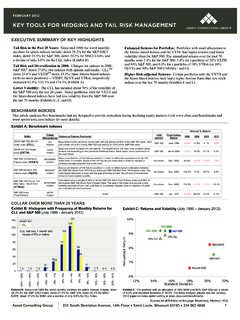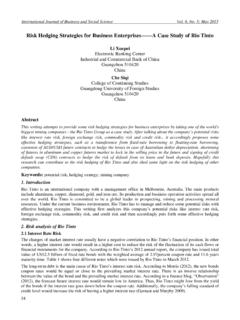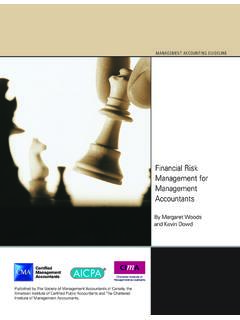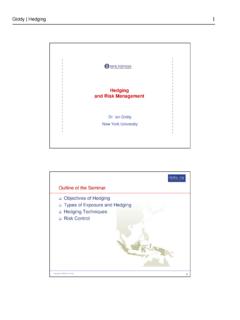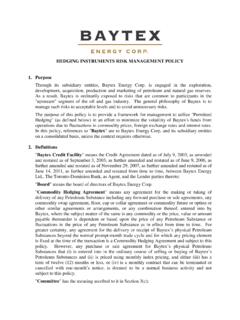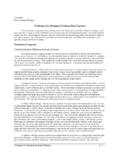Transcription of RISK MANAGEMENT: PROFILING AND HEDGING - …
1 1 RISK management : PROFILING AND HEDGING To manage risk, you first have to understand the risks that you are exposed to. This process of developing a risk profile thus requires an examination of both the immediate risks from competition and product market changes as well as the more indirect effects of macro economic forces. We will begin this chapter by looking at ways in which we can develop a complete risk profile for a firm, where we outline all of the risks that a firm is exposed to and estimate the magnitude of the exposure. In the second part of the chapter, we turn to a key question of what we should do about these risks . In general, we have three choices.
2 We can do nothing and let the risk pass through to investors in the business stockholders in a publicly traded firm and the owners of private businesses. We can try to protect ourselves against the risk using a variety of approaches using options and futures to hedge against specific risks , modifying the way we fund assets to reduce risk exposure or buying insurance. Finally, we can intentionally increase our exposure to some of the risks because we feel that we have significant advantages over the competition. In this chapter, we will consider the first two choices and hold off on the third choice until the next chapter. Risk Profile Every business faces risks and the first step in managing risk is making an inventory of the risks that you face and getting a measure of the exposure to each risk.
3 In this section, we examine the process of developing a risk profile for a business and consider some of the potential pitfalls. There are four steps involved in this process. In the first step, we list all risks that a firm is exposed to, from all sources and without consideration to the type of risk. We categorize these risks into broad groups in the second step and analyze the exposure to each risk in the third step. In the fourth step, we examine the alternatives available to manage each type of risk and the expertise that the firm brings to dealing with the risk. Step 1: A listing of risks Assume that you run a small company in the United States, packaging and selling premium coffee beans for sale to customers.
4 You may buy your coffee beans in 2 Columbia, sort and package them in the California and ship them to your customers all over the world. In the process, you are approached to a multitude of risks . There is the risk of political turmoil in Columbia, compounded by the volatility in the dollar-peso exchange rate. Your packaging plant in California may sit on top of an earthquake fault line and be staffed with unionized employees, exposing you to the potential for both natural disasters and labor troubles. Your competition comes from other small businesses offering their own gourmet coffee beans and from larger companies like Starbucks that may be able to get better deals because of higher volume.
5 On top of all of this, you have to worry about the overall demand for coffee ebbing and flowing, as customers choose between a wider array of drinks and worry about the health concerns of too much caffeine consumption. Not surprisingly, the risks you face become more numerous and complicated as you expand your business to include new products and markets, and listing them all can be exhausting. At the same time, though, you have to be aware of the risks you face before you can begin analyzing them and deciding what to do about them. Step 2: Categorize the risks A listing of all risks that a firm faces can be overwhelming. One step towards making them manageable is to sort risk into broad categories.
6 In addition to organizing risks into groups, it is a key step towards determining what to do about these risks . In general, risk can be categorized based on the following criteria: a. Market versus Firm-specific risk: In keeping with our earlier characterization of risk in risk and return models, we can categorize risk into risk that affects one or a few companies (firm-specific risk) and risk that affects many or all companies (market risk). The former can be diversified away in a portfolio but the latter will persist even in diversified portfolios; in conventional risk and return models, the former have no effect on expected returns (and discount rates) whereas the latter do.
7 B. Operating versus Financial Risk: Risk can also be categorized as coming from a firm s financial choices (its mix of debt and equity and the types of financing that it uses) or from its operations. An increase in interest rates or risk premiums 3 would be an example of the former whereas an increase in the price of raw materials used in production would be an example of the latter. c. Continuous risks versus Event Risk: Some risks are dormant for long periods and manifest themselves as unpleasant events that have economic consequences whereas other risks create continuous exposure. Consider again the coffee bean company s risk exposure in Columbia.
8 A political revolution or nationalization of coffee estates in Columbia would be an example of event risk whereas the changes in exchange rates would be an illustration of continuous risk. d. Catastrophic risk versus Smaller risks : Some risks are small and have a relatively small effect on a firm s earnings and value, whereas others have a much larger impact, with the definition of small and large varying from firm to firm. Political turmoil in its Indian software operations will have a small impact on Microsoft, with is large market cap and cash reserves allowing it to find alternative sites, but will have a large impact on a small software company with the same exposure.
9 Some risks may not be easily categorized and the same risk can switch categories over time, but it still pays to do the categorization. Step 3: Measure exposure to each risk A logical follow up to categorizing risk is to measure exposure to risk. To make this measurement, though, we have to first decide what it is that risk affects. At its simplest level, we could measure the effect of risk on the earnings of a company. At its broadest level, we can capture the risk exposure by examining how the value of a firm changes as a consequence. Earnings versus Value Risk Exposure It is easier to measure earnings risk exposure than value risk exposure.
10 There are numerous accounting rules governing how companies should record and report exchange rate and interest rate movements. Consider, for instance, how we deal with exchange rate movements. From an accounting standpoint, the risk of changing exchange rates is captured in what is called translation exposure, which is the effect of these changes on the current income statement and the balance sheet. In making translations of foreign 4 operations from the foreign to the domestic currency, there are two issues we need to address. The first is whether financial statement items in a foreign currency should be translated at the current exchange rate or at the rate that prevailed at the time of the transaction.
